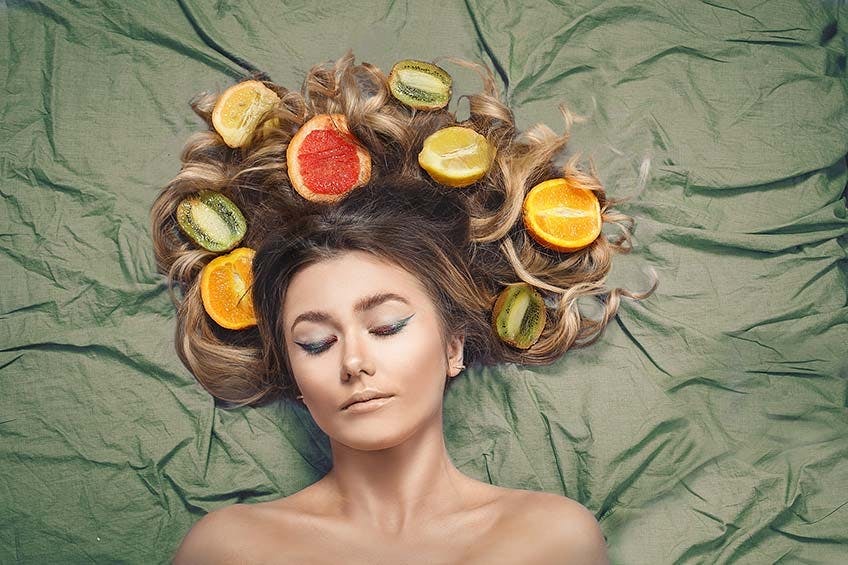How to recover healthy hair from your unsightly stay home hair condition!
Since many of us have been unable to enjoy our usual 8-10 week trim, intensive conditioning, colouring and styling, that means bad hair days have become the ‘norm’ during the lockdown. Nutritional therapist Jackie Newson, explains which nutrients are important for hair health to help convert your tired, lacklustre locks into crowing glory again.
Disastrous DIY quarantine haircuts, extensive grey roots, and frizzy tangled locks may be easy to ignore whilst you’ve been confined to your own home hiding your coronavirus hair. But now that lockdown is being lifted it’s time to take a good look in the mirror and take steps to tame your mane. Many health experts agree that the condition of your hair is often a reflection of your general health. So when you’re feeling low or stressed and anxious, your hair is likely to be dull, lifeless, itchy, oily or just downright messy!
For a lot of people, self-esteem is tied in with body image and the state of your hair may play a contributory role. You may feel less than confident when your hair’s not looking its best and this could even impact on how capable you feel at work or during daily activities. Keeping on top of your hair condition means there’s one less thing to worry about. Here’s our round up of useful tips to make styling a pleasure rather than a chore.
Get to know your hair
The hair shaft is the part of the hair that can be seen above your scalp and is composed primarily of the protein keratin. Hair also contains collagen, fatty acids and minerals and is made by cells similar to those cells found in the skin. Hair consists of three layers, the cuticle, cortex and medulla, and grows from a hair bulb situated at the base of each hair follicle. The blood capillaries surrounding each follicle carry nourishment needed for hair-cell reproduction and growth.
The outermost layer of the hair is called the cuticle and is designed to protect the inner cortex, which gives your hair its strength and elasticity. A healthy cuticle is vital as it helps to shield the hair from damage caused by chemical treatments, harsh weather and toxins.
Internally, the health of your hair depends on adequate circulation to the root and the amount of nutrients present in your blood. Poor circulation tends to lead to poor hair growth and condition. A lack of complete proteins in the diet is likely to be important when it comes to poor hair health. Externally, keeping the cuticle layer smooth and flat protects the inner layer and helps to keep your hair bouncy and shiny. This involves:
- Regularly conditioning your hair
- Minimising chemical processes (hair dyes and hair bleach)
- Protecting your hair from the sun
- Minimising heat treatments (straighteners, curling tongs)
- Avoiding over manipulating hair with improper use of tools
If you haven’t been paying extra attention to your normal hair care routine over lockdown then you may have developed one of these following hair issues…
What causes dandruff?
Dandruff (Pityriasis capitis) is characterised by excessive flaking and abnormal shedding of the skin on the scalp creating little dry skin flakes that can be seen in the hair and on your clothes. This may be linked to a scalp fungus called Malassezia globosa, which feeds on sebum (oil produced by the sebaceous glands), contributing to an inflammatory reaction in susceptible people resulting in erratic shedding of skin cells.
Dandruff is a condition that only affects the scalp which becomes unsightly, sore, red and itchy and a potential source of anxiety for many people. If you suffer from dandruff then it may be the following factors could be contributing to your condition:
- climate and excessive perspiration
- allergic reaction to chemicals in hair products
- genetic predisposition
What’s the difference between dandruff and dry scalp?
Dry scalp is an entirely different problem to dandruff. To start with it’s far more common and much easier to treat. A dry scalp is normally due to overuse of detergent-laden shampoos and frequent chemical treatments on the hair. It may be avoided by choosing good quality hair products, rinsing the hair thoroughly after washing and cutting down on the number of chemical treatments that you use on your hair and scalp.
Dry and brittle hair is prone to breaking
A raised cuticle gives the hair a dry, dull appearance. It is more prone to splitting and breaking often and as the hair is on a long growth cycle, around 1cm a month, it may take a little time to rectify. Factors that may contribute to brittle, dry hair include:
- A diet low in protein
- Poor digestion
- Poor quality shampoo
- Overuse of hair styling products and equipment
- Permanent hair dyes and bleach
- Excessive sun exposure
- Hormone imbalances
- Poor nutrient status, for example, some minerals, vitamins, and protein
Are you experiencing hair loss?
Daily hair loss is part of the natural cycle of hair growth and renewal, however, in some cases, hair loss may be excessive. Because hair is primarily composed of protein, a diet low in protein or an inability to digest protein may result in a change in strength, colour, texture and growth of the hair. Many minerals work as cofactors for the enzymes that digest proteins and other nutrients help to incorporate proteins into the hair structure. These key nutrients include B vitamins, biotin, inositol, magnesium and zinc. In fact, a lack of iron, known as anaemia, is also associated with increased hair loss.
Aside from diet and nutrient status, factors such as shock, trauma and sudden weight loss, plus genetic influences such as hereditary male pattern baldness can also be linked with hair loss. For women and men, hormonal influences include low thyroid function and testosterone, oestrogen or progesterone imbalance, which may all contribute to hair loss. Other factors linked to hair loss include:
- Medications –as side effects of chemotherapy, radiotherapy, blood thinners, gout medication and birth control pills.
- Chemical damage – due to excessive bleaching and the heavy use of chemical agents that permanently curl or straighten hair.
- Hair ties–frequent use of hair ties or long heavy hair may pull on the scalp and weaken hair root and structure.
- Autoimmune disease – one example is alopecia.
Greasy or oily hair
Oily hair appears dirty, greasy and lacklustre and may also smell unpleasant. This is due to excessive production of sebum, which spreads onto the scalp and surrounds the hair shaft. Once on the scalp it mixes with dead skin cells, waste products and sweat - a sticky combination that may leave you with an itchy scalp. Sebum is important for maintaining the lubrication and waterproofing of the hair shaft and scalp. However, stress, hormone imbalance, digestive issues, poor nutrition and even overly aggressive anti-grease shampoos and hair products may influence excessive sebum production.
Eat your way to healthy hair
Time to troubleshoot the hair problems mentioned above and avoid those dreaded bad hair days. A short cut to beautiful, strong, shiny hair involves a healthy diet and a good balance of key essential hair nutrients to help maintain protein production, hormone balance, healthy circulation, adequate oxygenation and collagen formation. Let’s take a look as those key essential hair nutrients in more detail…
- B vitamins – are particularly important for hair health. Biotin contributes to the maintenance of normal hair and vitamin B6 together with vitamin B12 contributes to normal red blood cell formation – just what you need to get oxygen and nutrients circulating in the blood. Vitamin B6 also plays a part in hormone balance as it contributes to the regulation of hormonal activity. When it comes to scalp health, vitamin B3 plays an essential role because of its contribution to the maintenance of normal skin. Supplementing with a B vitamin complex such as liposomal Altrient B, which has superior absorption and rapid delivery to the hair cells is a great option if you think your diet is short in these nutrients.
- Essential fatty acids – are integral to the health of the hair cuticle and cortex. When the body is short of essential fats this tends to be reflected in the hair condition which may become dull, dry and brittle.
- Mighty minerals – zinc and magnesium are equally important since zinc contributes to the maintenance of normal hair and magnesium contributes to normal protein synthesis, an absolute must for hair formation. One interesting supplement is Altrient Magnesium Magtein for maximised absorption of a special form of magnesium called magnesium L-threonate.
- Vitamin C – is another key vitamin fundamental to hair health because of its important role in contributing to normal collagen formation for the normal function of skin and its contribution to the protection of cells from oxidative stress, something which damaged hair may need a lot of help with. If you are looking for a nutrition supplement, then Altrient C is an award-winning liposomal product turning heads in the beauty industry.
Six healthy hair diet tips
- At least 5 to 10 portions a day of a variety of fruit and vegetables to gain an adequate supply of vitamin C.
- Meat, fish, eggs, whole grains and green leafy vegetables, to top up on those amazing B vitamins.
- Two portions a week of oily fish like salmon, mackerel and sardines, as well as nuts and seeds and the oils from these foods, which are a great source of omega 3 essential fatty acids.
- Foods rich in zinc such as seafood, nuts, pumpkin seeds, whole grains, meat, lentils and chickpeas.
- A good mix of protein foods to gain the full range of essential amino acids. Choose from meat, fish, eggs, dairy foods, nuts, seeds, lentils, beans, quinoa and soya products.
- Foods that are good sources of iodine, if you suspect you have low thyroid function e.g. sea salt, sea vegetables, seafood, fish, potato and eggs.
Don’t forget – exercise and stress!
Exercise improves blood circulation, which increases blood flow to all parts of the body including the scalp and your hair follicles. Stimulating the circulation is a great way to carry nutrients, oxygen and growth factors to the cells that need them.
Exercise also helps to alleviate stress levels, which may contribute to poor digestion, the depletion of key nutrients and hair loss, so get up and get moving if you want to help maintain a glossy, bouncy head of hair. And if you’re a fan of yoga, which is a great discipline to help combat stress, then many of the postures involve promoting blood flow to the head so you’re onto a winner!
Jacqueline Newson BSc (Hons) Nutritional Therapy
REFERENCES
D'Souza P, Rathi SK. Shampoo and Conditioners: What a Dermatologist Should Know?. Indian J Dermatol. 2015;60(3):248‐254.
Philip Kingsley. The Hair Structure. https://www.philipkingsley.co.uk/hair-guide/hair-science/the-hair-structure . [Accessed 9.5.20.]
Scott-Boyer, M. P. et al. A network analysis of cofactor-protein interactions for analyzing associations between human nutrition and diseases. Sci. Rep. 2016; 6, 19633.
Rogers GE. Known and Unknown Features of Hair Cuticle Structure: A Brief Review. Cosmetics 2019; 6,32: 1-8.
Yang FC, Zhang Y, Rheinstädter MC. The structure of people's hair. PeerJ. 2014; 2:e619.



